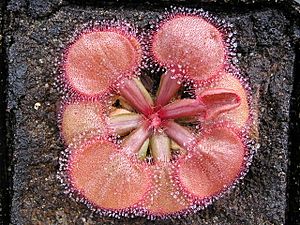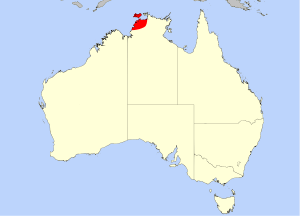Drosera falconeri facts for kids
Quick facts for kids Drosera falconeri |
|
|---|---|
 |
|
| Scientific classification | |
| Genus: |
Drosera
|
| Species: |
falconeri
|
 |
|
| Distribution of D. falconeri in Australia | |
Drosera falconeri is a special carnivorous plant that belongs to the Drosera genus, also known as sundews. This plant is found only in the Northern Territory of Australia. It's unique because it catches insects to get the nutrients it needs!
Contents
What it Looks Like
Drosera falconeri might remind you a bit of the famous Venus flytrap. Both plants have wide, flat leaves. Scientists have studied D. falconeri to understand how sticky-leaved plants, like sundews, might have evolved into snap-trap plants, like the Venus flytrap. They both face the challenge of keeping their prey from escaping!
This plant is a tropical perennial, meaning it lives for more than two years and grows in warm climates. It forms a flat circle of leaves, called a rosette, which is common for sundews. Its leaves lie flat on the ground. When the plant first flowers, its leaves are usually smaller, but they grow bigger as the season goes on.
Mature leaves are shaped like kidneys, about 1.5 cm (0.6 in) long and 2 cm (0.8 in) wide. Older plants can have leaves up to 3 cm (1.2 in) wide. What makes this sundew special in its group is how large its leaves are and how flat they lie on the soil.
The edges of the leaves have sticky, stalked glands called tentacles. These tentacles produce a gooey substance called mucilage that traps insects. Shorter glands are found in the middle of the leaf. The underside of the leaf has clear veins and a few white, non-sticky hairs. The leaf stalks (called petioles) are usually 10 mm (0.4 in) long and vary in width. The top of the petiole is smooth, but its edges and underside have hairs, just like the bottom of the leaf.
The plant usually grows one or two flower stalks, each about 8 cm (3.1 in) long. Each stalk has about 12 white or pink flowers. Each flower sits on a small stem 3–5 mm (0.1–0.2 in) long. The flower stalk and the sepals (leaf-like parts protecting the flower bud) have a few white hairs.
The flowers have petals that are 7 mm (0.3 in) long and 4 mm (0.2 in) wide. They have five white stamens (the parts that produce pollen) and a central ovary (where seeds develop). D. falconeri typically flowers from November to December. Only one flower opens at a time, and it lasts for just one day.
Surviving the Dry Season
During the dry season, the leaves of Drosera falconeri die back. But the plant doesn't die! It forms a special bulb-like structure made of tightly packed leaf bases just below the soil. This helps it survive the dry, hot weather. The hard clay soil acts like a blanket, keeping the plant safe. Other similar sundew species use dense white hairs for protection, but D. falconeri uses the soil.
When the first rains of the wet season arrive, the plant quickly starts growing again. It forms new roots, leaves, and flower stalks. It needs to grow fast to build up energy and produce seeds before the next dry season. Its new roots are thick and white, mainly used for storing water. Older roots become thinner and help anchor the plant.
Plant Hybrids
Drosera falconeri can sometimes create hybrids with other sundew species in its group, the D. petiolaris complex. A hybrid is a new plant that results from two different parent plants.
In the wild, these hybrids are rare. This is because the specific soil types that each parent plant needs don't often overlap. The first natural hybrid found was a mix of D. falconeri and D. dilatato-petiolaris. What's interesting is that the seeds from this hybrid can grow into new plants, which is unusual for sundew hybrids.
There are about four different forms of this hybrid found in nature. Some are smaller, about 4–5 cm (1.6–2.0 in) wide, while others can be up to 10 cm (3.9 in) wide. The leaves also vary in size. Some hybrids will grow in clumps, like D. dilatato-petiolaris, while others will grow alone. Drosera falconeri also forms hybrids with D. petiolaris.
Scientists have also made artificial hybrids of D. falconeri in labs or greenhouses.
Where it Lives and How it Grows
Drosera falconeri is common in the northern coastal parts of the Northern Territory in Australia. It was first found along the Finniss River in sandy soils that were a bit alkaline (the opposite of acidic).
You can find it growing in grey, silty clay soils in places like Palmerston and Berry Springs, and also on Melville Island.
Most carnivorous plants prefer acidic soils. But D. falconeri is special because it can grow in sandy soils that contain calcium carbonate and have high pH levels (meaning they are alkaline). When it was first discovered, the soil pH was recorded as 8, which is quite alkaline. At the place where it was first found, tall, thick grass covered the small group of plants.
How it Was Discovered and Named
Drosera falconeri was first found in 1980 by a person named Mr. Falconer. He was collecting plants and fish near the Finniss River for Peter Tsang, who loved carnivorous plants. Tsang then sent samples to other botanists.
Peter Tsang also wrote a short announcement about this new plant in a magazine called the Carnivorous Plant Newsletter in June 1980. He suggested naming the plant falconeri to honor Mr. Falconer, who discovered it.
However, it wasn't until 1984 that Katsuhiko Kondo officially described the species. This formal description is needed for a plant to be recognized by the rules of plant naming. Kondo's description was part of an article about three new species in the D. petiolaris group. The main sample of the plant, called the holotype, is kept at Hiroshima University. Copies of this sample, called isotypes, were sent to other plant collections around the world.
For a while, people only knew about this plant from one location, and the description of that spot was a bit vague. When Peter Tsang passed away in 1984, people worried that the exact location of the plant population was lost forever. But luckily, more field studies found several new places where D. falconeri grows!
Scientists quickly realized that D. falconeri belonged to the D. petiolaris group, specifically in the subgenus Lasiocephala. This was suspected early on because of how its dormant buds and roots looked. Later studies confirmed this idea.
Growing Drosera falconeri
Peter Tsang was the first person to grow Drosera falconeri shortly after it was discovered. He then shared living plants with others so that this new species could be grown and studied.
This plant is considered a bit tricky to grow. During its dry season rest period, D. falconeri forms a tight ball of leaves that looks like a sleeping bud. People often grow it in a mix of peat and sand or perlite. You can also grow new plants from leaf cuttings by putting them in pure water.
A botanist named Allen Lowrie found that some sundew species in this group can grow all year round without going dormant if they have the right conditions. Lowrie also noticed that these plants often have deep red leaves in the wild, but they tend to be greener when grown by people. This is probably because they don't get as much sunlight when cultivated.
See also
 In Spanish: Drosera falconeri para niños
In Spanish: Drosera falconeri para niños

